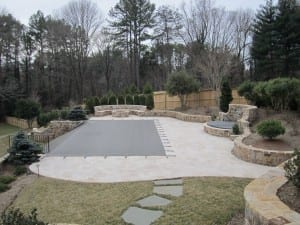Town & Country Pool Builders, serving Virginia, Maryland & DC explain winter pool closing
While there may be one last hurrah for a warm, summery day chances are you will be thinking of closing your pool for the season. When this time comes, you will want to spend time with your swimming pool contractor from Town & Country Pool Builders and schedule a time for them to get the pool ready for the winter. Taking time to properly winterize the pool is crucial to making certain it survives the cold, possibly snowy winter months and it also makes it much easier to open the pool the following season.
Here are some of the steps that will be taken when your pool is closed for the season:
- The best time to close the pool is when the temperatures begin to dip into the 60s or 70s in the daytime and the 40s overnight — this typically happens in October. After the water temperatures have begun to lower, the demand for chlorine is lessened and this will save you money over the winter because its potency will last longer. Closing your swimming pool “too early” could lead to the water being warm enough to allow for the growth of algae.
- Swimming pool contractors in Virginia, Maryland and DC believe in performing visual inspections of swimming pools before closing them for their clients for the winter months. A visual inspection will highlight any possible defects in the pool structure and in the equipment. If any potential damage areas are noted, it is best to have it repaired or replaced prior to closing the pool as a way to prevent further damage from occurring.
- The pool water chemical levels will be tested prior to the pool being closed and will be balanced if necessary. Pool winterizing chemicals will be added to the water to make certain algae doesn’t grow during the winter months when you can’t see what’s going on under the pool cover.
- Water levels will need to be lowered and water will be drained from the pump as well. Your contractor will lower the water levels by up to a foot and a half below the skimmer; this is done to prevent any water from draining back into the pool and preventing freezing and damage to the pipes. The jet and skimmer holes will be plugged.
- All equipment and timers will be shut off to make certain that no equipment gets inadvertently turned on which could damage it if there isn’t proper water flow.
- Your pool cover will be placed and properly secured. It’s best if you take time at least weekly during the winter to check the pool cover and remove any standing snow or water to prevent the cover from falling into the pool.
- As a final step your pool contractor will make certain all safety measures such as locks on the gates and on the pool cover itself are in place, but it is also the responsibility of the homeowner to check on these safety measures throughout the year because winter won’t prevent a curious child from attempting to get into the pool if he or she wants to.
Now that it’s hitting mid-October, it’s the time to give a call to your pool contractor and get on his schedule for winter pool closing.


Thursday March 7, 2024 the office will be closed for training. ... See MoreSee Less
0 CommentsComment on Facebook
Project with Rolling Acres Landscaping - check them out - www.rollingacreslandscaping.com/portfolio/award-winning-nw-dc/ ... See MoreSee Less
0 CommentsComment on Facebook